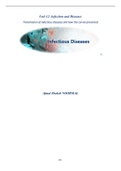Unit 12: Infection and Diseases
Transmission of infectious diseases and how this can be prevented
[1]
Ajmal Shekeb NOORMAL
<#>
,Unit 12 Ajmal Shekeb NOORMAL
Introduction
I volunteer for a national charity that helps people affected by armed conflicts, natural
disasters, or epidemics. Long-term initiatives are administered by the foundation to address
global health crises. My task as a volunteer is to collect data on the causes and transmission
of infectious diseases, as well as the methods used to combat their spread.
The aim of this assignment is to learn how diseases spread and how to prevent them from
spreading. I will have to evaluate the different approaches and interventions used to
prevent infectious disease transmission and spread. I will also look at how organisations can
help prevent the spread of infectious diseases. Vaccination services and their relevance
should be included in my review.
Tiny organisms such as bacteria, viruses, fungi, and parasites cause infectious diseases. Our
bodies are home to a variety of microorganisms. These species can be either harmful or
beneficial. However, certain small organisms can cause disease in some circumstances.
It has the potential to transfer infectious diseases from one human to another. Insects and
other species are responsible for certain diseases. Other diseases may grow as a result of
consuming contaminated food or drinking contaminated water, or because of being
exposed to small organisms in the environment.
Assignment B 2
,Unit 12 Ajmal Shekeb NOORMAL
How Diseases Can be Transmitted
Vector:
A vector is a living organism that spreads an infectious agent from an infected animal to
humans or other animals. Mosquitoes, ticks, flies, fleas, and lice are all common arthropod
vectors.[2] In other words, Vectors are living organisms that can transmit infectious
pathogens between humans, or from animals to humans. Many of these vectors are
bloodsucking insects, which ingest disease-producing microorganisms during a blood meal
from an infected host (human or animal) and later transmit it into a new host, after the
pathogen has replicated. Often, once a vector becomes infectious, they are capable of
transmitting the pathogen for the rest of their life during each subsequent bite/blood
meal.[3]
[4] Image 2, Vector
Vectors can transmit infectious diseases either actively or passively:
Biological vectors: such as mosquitoes and ticks may carry pathogens that can multiply
within their bodies and be delivered to new hosts, usually by biting.
Mechanical vectors: such as flies can pick up infectious agents on the outside of their bodies
and transmit them through physical contact.[2]
Vector-borne diseases are diseases spread by insects or spiders. Many vector-borne
diseases are zoonotic, meaning they may be transmitted directly or indirectly from animals
to humans. Lyme disease, tick-borne encephalitis, West Nile virus, Leishmaniasis, and
Crimean-Congo haemorrhagic fever are only a few examples.[2]
Human illnesses caused by parasitic, viral, and bacterial infections spread by vectors are
known as vector-borne diseases. Malaria, dengue fever, schistosomiasis, human African
trypanosomiasis, leishmaniasis, Chagas disease, yellow fever, Japanese encephalitis, and
Assignment B 3
, Unit 12 Ajmal Shekeb NOORMAL
onchocerciasis kill over 700,000 people per year, according to the World Health
Organisation. [3]
The first major discovery of a disease vector came from Ronald Ross in 1897, who
discovered the malaria pathogen when he dissected a mosquito.[5]
In the European Union, many vector-borne diseases are listed as emerging infectious
diseases (diseases that first occur in a population or that may have occurred previously but
are increasingly growing in occurrence or geographic range).
Some vectors have the ability to travel long distances. The transmission ranges of vector-
borne zoonotic diseases may be affected as a result.
Human travel and foreign trade, for example, can introduce vectors to new geographic
areas, as can animal movement, such as cattle, migratory birds, shifting agricultural
practises, or the wind.
Other factors, such as climatic conditions, may play a role in their establishment and
persistence in new areas.[2]
The table below is a non-exhaustive list of vector-borne diseases, sorted by the vector by
which they are transmitted. The pathogen that causes the disease in humans is also shown
in the list: [3]
Vector Disease caused Type of pathogen
Mosquito Aedes Chikungunya Virus
Dengue Virus
Lymphatic filariasis Parasite
Rift Valley fever Virus
Yellow Fever Virus
Zika Virus
Anopheles Lymphatic filariasis Parasite
Malaria Parasite
Culex Japanese encephalitis Virus
Lymphatic filariasis Parasite
West Nile fever Virus
Aquatic snails Schistosomiasis (bilharziasis) Parasite
Blackflies Onchocerciasis (river blindness) Parasite
Fleas Plague (transmitted from rats to humans) Bacteria
Tungiasis Ectoparasite
Lice Typhus Bacteria
Louse-borne relapsing fever Bacteria
Assignment B 4




